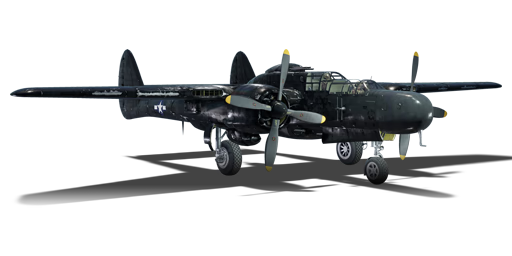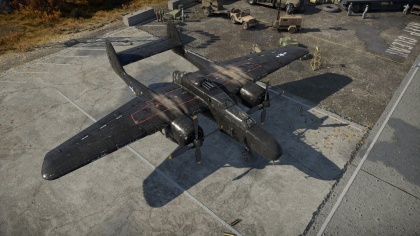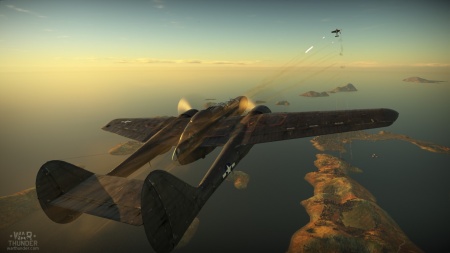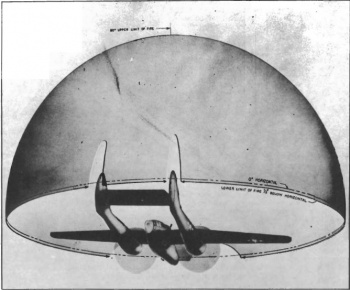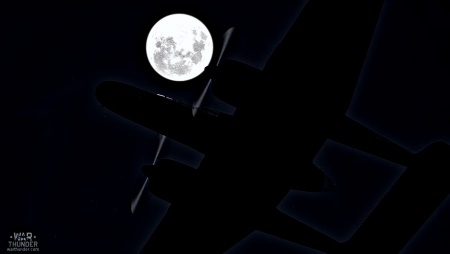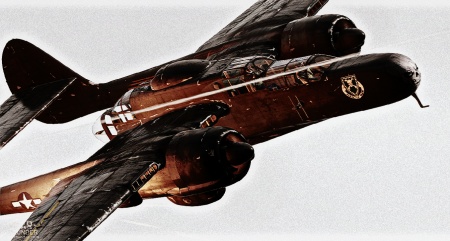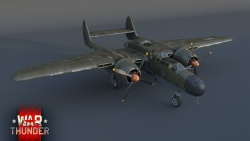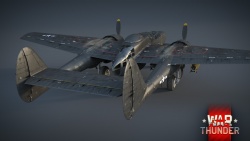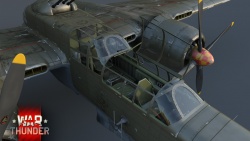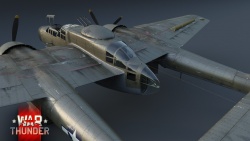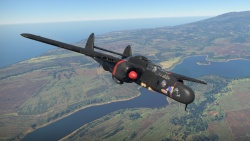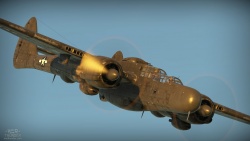Difference between revisions of "P-61C-1"
(→Armaments) |
(→Survivability and armour) |
||
| Line 125: | Line 125: | ||
* 9.5 mm Steel - Gun turret ammo protection plates | * 9.5 mm Steel - Gun turret ammo protection plates | ||
* 12.7 mm Steel - Turret protection plate | * 12.7 mm Steel - Turret protection plate | ||
| + | |||
| + | With such beefy engines on the {{PAGENAME}} it stood to reason that armour protection would be necessary to help protect the pilot and the gunner during a conflict against a potential bomber or attacker aircraft which may have defensive gunner positions. Since the main source of incoming bullets would most likely come towards the front of the {{PAGENAME}} from defensive positions, it was reasonable to protect both the pilot and the gunner position, while the radio/radar operator received most of their protection from the gun turret and radio/radar equipment as there is no protection provided from the rear plane of the aircraft. | ||
| + | |||
| + | The pilot is afforded protection through the bulletproof canopy windscreen which is 60 mm thick and a 12.7 mm steel plate located directly behind the radar unit in the nose. These two items will aid to protect the pilot in the event a bomber or attacker’s defensive gunners fire on an attacking {{PAGENAME}}, however, note that these protections will wain in their ability if the pilot of the Black Widow decides to take another aircraft head-on, especially if that aircraft is sporting 20 or 30 mm autocannons. | ||
| + | |||
| + | The {{PAGENAME}}’s gunner sits directly behind the pilot, however, his station is slightly elevated giving him an unobstructed view of the front and side of the aircraft, allowing him great visibility to be able to aim and fire the machine gun turret. Since the gunner station is elevated, the gunner is exposed to incoming fire which the pilot's protective plate and armoured windscreen will not cover. To remediate this there are two 12.7 mm steel plates which the gunner can swing in front of him for protection or out of the way when not in use. | ||
| + | |||
| + | The rest of the armour protection for this aircraft are several steel plates which protect the critical components and the ammunition of the turret. Since the turret is mechanical in operation (remotely by the gunner or radio/radar operator), it is important that critical components are protected to ensure continued usage, as when the remote components fail, the turret is useless. Protecting the ammunition storage is also important not only to have it available for usage, setting the ammunition on fire or off in the storage container could cause catastrophic results to the aircraft and crew in the event they start firing. | ||
== Armaments == | == Armaments == | ||
Revision as of 16:53, 7 November 2019
Contents
| This page is about the American twin-engine fighter P-61C-1. For the premium version, see P-61A-1. |
Description
The P-61C-1 is a rank American twin-engine fighter
with a battle rating of (AB), (RB), and (SB). It was introduced in Update 1.57 "Battle March".
The P-61C-1 is a heavy twin-engine strike fighter. It is designed to deliver as much damage as possible, and therefore makes a great ground attack aircraft and bomber-hunter.
It has four cannons placed are under the belly of the aircraft with an additional four Browning machine guns in the upper turret. The cannons combined with the gunner and turret are able to make quick work of any plane which stands in your way. The machine gun turret can be used, defensively and offensively by the gunner. It is excellent in bomber hunting and it excels when used with boom and zoom tactics. However, it does not have a decisive defensive armament which can provide essential protection from the low rear or belly attacks. It also is unable to turn fight, as it is extremely large, slow and loses any advantages it has easily.
Turret defensive angles are limited, it can not aim any lower than the elevator. If an enemy plane is lower than the elevator, you will need to put the plane into a steep climb or dive. It also offers very weak crew protection from head-on attacks.
The P-61C-1 has four AN/M2 cannons with 800 rounds in total (200 rpg). It also has a turret with four Browning machine guns it has 2120 rounds in total (530 rpg).
Its armament is exceptionally powerful for its battle rating, being essentially slightly faster firing Hispano Mk.IIs. Additionally, its firepower is exclusively mounted on the fuselage, making it very accurate for long-range shooting. However, note that unless the new 20 mm cannons upgrade is researched, they are somewhat inaccurate (especially in a head-on pass). However, this is nowhere near as visible as on planes where the cannons are wing-mounted, like the F4U-1C. Like with all other AN/M2 cannons, it is recommended to use either the Default or Stealth belts due to their higher composition of HEF-I shells.
The most notable aspect of the P-61C-1's armament is that the 4 x 12.7 mm machine gun turret is mounted on the roof of the aircraft and is capable rotating a full 360 degrees on the horizontal axis and almost 90 degrees upwards. Not only does this give the plane an effective defensive armament if an enemy plane is above the P-61, but it also makes the gunner able to actively fire at the same target as the pilot, or fire at planes that the pilot cannot get an immediate gun solution on. Keep in mind, however, that the turret cannot aim downwards at all, leaving the belly of the aircraft all the way up to wing level unprotected. Its utility is best shown in situations where you are hunting high altitude bombers. Instead of struggling to climb up to the bomber's attitude and keeping up the speed, you could be flying 1 - 1.2 km below the bomber, catch up with it, then manually aim the turret which has 360 degrees of coverage to snipe the plane down with 4 x 12.7 mm machine guns. This is even more effective towards bombers which have blind spots in the belly.
General info
Flight performance
Describe how the aircraft behaves in the air. Speed, manoeuvrability, acceleration and allowable loads - these are the most important characteristics of the vehicle.
| Characteristics | |||||||
|---|---|---|---|---|---|---|---|
| Stock | |||||||
| Max Speed (km/h at 7,100 m) |
Max altitude (meters) |
Turn time (seconds) |
Rate of climb (meters/second) |
Take-off run (meters) | |||
| AB | RB | AB | RB | AB | RB | ||
| 656 | 643 | 26.3 | 27.5 | 12.2 | 12.2 | 457 | |
| Upgraded | |||||||
| Max Speed (km/h at 7,100 m) |
Max altitude (meters) |
Turn time (seconds) |
Rate of climb (meters/second) |
Take-off run (meters) | |||
| AB | RB | AB | RB | AB | RB | ||
| 732 | 692 | 23.8 | 25.0 | 21.3 | 16 | 457 | |
Details
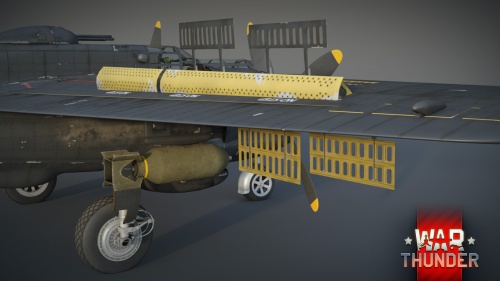
| Features | ||||
|---|---|---|---|---|
| Combat flaps | Take-off flaps | Landing flaps | Air brakes | Arrestor gear |
| ✓ | ✓ | ✓ | ✓ | X |
| Limits | ||||
|---|---|---|---|---|
| Wing-break speed (km/h) |
Gear limit (km/h) |
Combat flaps (km/h) |
Max Static G | |
| + | - | |||
| 340 | ~7 | ~3 | ||
| Optimal velocities | |||
|---|---|---|---|
| Ailerons (km/h) |
Rudder (km/h) |
Elevators (km/h) |
Radiator (km/h) |
| < 530 | < 420 | < 450 | > 337 |
| Compressor (RB/SB) | ||
|---|---|---|
| Setting 1 | ||
| Optimal altitude | 100% Engine power | WEP Engine power |
| 8,000 m | 2,200 hp | 2,783 hp |
Survivability and armour
- 12.7 mm Steel - Nose armour plating (behind radar unit)
- 60 mm Bulletproof glass - Pilot and gunner armoured windscreens
- 12.7 mm Steel - Gunner front armour (folds out of the way when not in use)
- 12.7 mm Steel - Lower gun plate
- 9.5 mm Steel - Gun turret ammo protection plates
- 12.7 mm Steel - Turret protection plate
With such beefy engines on the P-61C-1 it stood to reason that armour protection would be necessary to help protect the pilot and the gunner during a conflict against a potential bomber or attacker aircraft which may have defensive gunner positions. Since the main source of incoming bullets would most likely come towards the front of the P-61C-1 from defensive positions, it was reasonable to protect both the pilot and the gunner position, while the radio/radar operator received most of their protection from the gun turret and radio/radar equipment as there is no protection provided from the rear plane of the aircraft.
The pilot is afforded protection through the bulletproof canopy windscreen which is 60 mm thick and a 12.7 mm steel plate located directly behind the radar unit in the nose. These two items will aid to protect the pilot in the event a bomber or attacker’s defensive gunners fire on an attacking P-61C-1, however, note that these protections will wain in their ability if the pilot of the Black Widow decides to take another aircraft head-on, especially if that aircraft is sporting 20 or 30 mm autocannons.
The P-61C-1’s gunner sits directly behind the pilot, however, his station is slightly elevated giving him an unobstructed view of the front and side of the aircraft, allowing him great visibility to be able to aim and fire the machine gun turret. Since the gunner station is elevated, the gunner is exposed to incoming fire which the pilot's protective plate and armoured windscreen will not cover. To remediate this there are two 12.7 mm steel plates which the gunner can swing in front of him for protection or out of the way when not in use.
The rest of the armour protection for this aircraft are several steel plates which protect the critical components and the ammunition of the turret. Since the turret is mechanical in operation (remotely by the gunner or radio/radar operator), it is important that critical components are protected to ensure continued usage, as when the remote components fail, the turret is useless. Protecting the ammunition storage is also important not only to have it available for usage, setting the ammunition on fire or off in the storage container could cause catastrophic results to the aircraft and crew in the event they start firing.
Armaments
Offensive armament
The P-61C-1 is armed with:
- 4 x 20 mm AN/M2 cannons, belly-mounted (200 rpg = 800 total)
The P-61C-1 is armed with 4 x 20 mm AN/M2 autocannons which are mounted in the belly of the fuselage just below the cockpit. Each cannon is outfitted with 200 rounds which may not seem like very much, but for those who are conservative by maintaining trigger control (short bursts), the ammunition will go a long way. Having the guns clustered along the lower fuselage allows for both in-close and longer-ranged shots without the necessity of having to calculate for convergence, the only factor will be bullet-drop over a distance which comes with practice. The cannons are very effective when used against any aerial vehicle encountered as they have no problem disabling engines and destroying wings or puncturing fuel tanks.
Suspended armament
The P-61C-1 can be outfitted with the following ordnance:
- Without load
- 4 x 500 lb AN-M64A1 bombs (2,000 lb total)
- 4 x 1,000 lb AN-M65A1 bombs (4,000 lb total)
The P-61C-1 is typically used as a night or strike fighter which is used to sneak up on unwary targets and destroy them with the four forward-facing 20 mm autocannons, however, there is an opportunity to mix it up as a multi-role aircraft and outfit the plane with bombs. There are four external hardpoint pylons in which either 500 lb or 1,000 lb bombs can be loaded for a total of either 2,000 or 4,000 lbs of bombs. With payloads like this, the P-61C-1 can rival the B-25 bombers in their payload deliveries. Unfortunately, for a strike fighter, the P-61C-1’s flight performance and manoeuvrability suffer when adding the extra 2,000 or 4,000 lbs of weight and can be a challenge to fly when attacked, however after the bombs have been released on their target, the P-61C-1 can get back to its heavy-fighter role.
Defensive armament
The P-61C-1 is defended by:
- 4 x 12.7 mm Browning M2 machine guns, dorsal turret (560 rpg outer + 500 rpg inner = 2,120 total)
It is interesting to note that later fighters started to reduce or eliminate the ability to carry defensive weapons in order to help save on weight and crew needed to staff the aircraft, however, it was deemed necessary that the P-61C-1 should have a defensive turret. Utilising state-of-the-art technology, four .50 calibre machine guns were mounted on a dorsal turret which could be remotely controlled by either the gunner (sitting behind the pilot) or the radio/radar operator located in a separate compartment at the rear of the fuselage. The four machine guns in the dorsal turret had virtually a full 360° rotation field with an elevation straight up. Effectively the only dead zones for this turret were the upper propeller arcs and the vertical stabilizers to the rear. When enemy aircraft attempt to sit on the rear of the aircraft, the pilot will need to pitch the aircraft up and to one side or the other to allow the gunner the best possible chance of bearing the turret down on the enemy fighter.
Usage in battles
The below tactics are recommended for all game modes:
How to offensively engage an enemy aircraft: Climb to high altitude and keep on a straight heading once you have seen the enemy. Overshoot the enemy plane, then perform a 180-degree turn. Make sure you stay on his tail and gradually descend. It is recommended to do something similar to a shallow descent, where you can keep speed and height to your advantage in case the enemy aircraft changes course and altitude. Do not perform a dive which requires you to dive straight down since you will rip the wings off and crash. Once you are within firing range, fire a short salvo from your cannons. A couple of bursts from the Black Widow are sufficient to easily rip an enemy plane to shreds.
How to perform defensive fighting: When you are being engaged by an enemy fighter, make sure you keep descending. Very Important: Do not allow enemy aircraft to get lower than your elevator on the tail boom. You have no defensive armament to cover the belly or full-rear of the plane; these are your weakest defended parts.
- Tactic one: Descend slowly. Put the plane in a steep dive that does not exceed your structural limit. However, it must be steep enough to provide the turret gunner full visibility of the enemy plane. The four Browning machine guns will take care of the enemy plane.
- Tactic Two: Put the plane in a steep climb and make sure you set the throttle to at least 70%. Jump into the gunner turret and operate it. This will be the most accurate and fastest way of shooting down the hostile plane. When you operate the turret, make sure you try and perform defensive manoeuvres when operating it i.e. sharp turns, rapidly decreasing in height as well as gaining height and changing the speed of the plane in an irrational way. This will give you a higher chance of survival against the enemy.
Radars
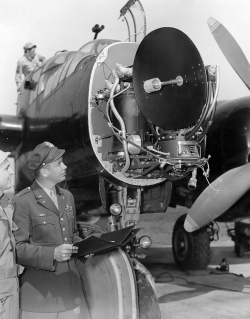
The P-61C-1 is equipped with an AI Mk. X search radar, located in the nose of the aircraft. The radar utilised a 29 in (74 cm) parabolic dish which it rotated at 360 rpm when set to ranges below 100 miles, however, it is slowed down to 100 rpm when set to the 100 miles setting. The scopes could be set to one of four ranges, 1, 10, 20 or 100 miles (1.6, 16, 32 or 160 km). The parabolic dish could be adjusted to different altitude settings which included 0° to 0°, -5° to +5°, +5° to +20°, and +20° to +50°. One of the benefits to the multiple choices in range and altitude settings of the radar was that it provided partial immunity to chaff and other radar interference or countermeasures deployed by the enemy.
| AI Mk. X - Target Detection Radar | |||
|---|---|---|---|
| Maximum Detection Range |
Guaranteed Detection Range |
Max Azimuth Scan Angle |
Max Elevation Scan Angle |
| 14,000 m | 8,500 m | ±75° | -20°/+40° |

Manual Engine Control
| MEC elements | ||||||
|---|---|---|---|---|---|---|
| Mixer | Pitch | Radiator | Supercharger | Turbocharger | ||
| Oil | Water | Type | ||||
| Controllable | Controllable Not auto controlled |
Controllable Auto control available |
Controllable Auto control available |
Separate | Not controllable 1 gear |
Not controllable |
Modules
| Tier | Flight performance | Survivability | Weaponry | ||
|---|---|---|---|---|---|
| I | Fuselage repair | Radiator | Turret 12 mm | ||
| II | Compressor | Airframe | New 12 mm MGs (turret) | FMBC mk.1 | |
| III | Wings repair | Engine | Offensive 20 mm | ||
| IV | Engine injection | Cover | New 20 mm cannons | FLBC mk.1 | |
The P-61C-1 is a thoroughbred Boom & Zoom aircraft. However, when the plane is first unlocked the flight performance will be very lacklustre to support this tactic. As such, the initial priority should be to improve the aircraft, by researching the upgrades that improve flight performance the most, namely Compressor, Engine and Engine injection. When the flight performance has reached a satisfactory level to allow for effective Boom & Zoom tactics, the priority should be switched towards researching the New 20 mm cannons upgrade in order to improve the accuracy of the cannons. After this is done, either finish upgrading the flight performance or focus on the turret upgrade. The bomb racks should be left to research last, as they are not critical to the P-61's main role as a fighter.
Pros and cons
Pros:
- The offensive armament is mounted under the belly of the plane, this provides excellent accuracy
- Powerful offensive armament with 4 x AN/M2 cannons with a total amount of 800 rounds
- Powerful defensive armament with 4 x Browning machine guns in a rotating turret, a total of 2,120 rounds
- Defensive armament is able to be used offensively by the gunner
- Very stable climb rate
- Engines are able to cool down very fast
- Able to perform sharp movements at low and high speed
- Excellent bomber hunter
- Very strong and rugged airframe; is able to fly with wingtips missing
- Can keep a lot of momentum from a gradual dive
- Can carry 4 x 1,000 lb bombs: enough to fully destroy one base or four light pillboxes
- Air brakes installed, allows you to slow down faster for a bomb run or landing
- Powerful engines when upgraded giving great acceleration
- Can fly on one engine
- Fairly good roll rate at high speeds thanks to spoilers
- Very little adverse yaw effect thanks to spoilers (SB)
- Has access to a target detection radar, with much better range than German radars found around this battle rating
- Low stalling speed, enabling it to land on carriers
Cons:
- Slow acceleration when not upgraded and requires a long airstrip to take off due to weight
- Uncompetitive roll rate at slow speeds
- Bad turn rate (utilise Immelmann turns, chandelles or normal loops)
- Due to size, slow to gain speed in a dive, however, can exceed structural limits if not careful. Per the pilot's manual while in a dive:
- Between 0 - 10,000 ft do not exceed 415 mph IAS
- Between 10,000 - 20,000 ft do not exceed 375 mph IAS
- Between 20,000 - 30,000 ft do not exceed 305 mph IAS
- Bottom of aircraft is unprotected
- Large body airframe, not meant for turn-fighting (Boom & Zoom or Boom & Run)
- Dorsal turret might hit friendlies when active under AI control during furballs or when you're behind friendlies chasing an enemy
History
In 1940, the British Purchasing Commission wanted a high-altitude, high-speed interceptor to shoot down Luftwaffe bombers when they raided British cities. This called for a high-endurance heavy fighter with Aerial Interception (AI) radars and specified gun armament mounted in a 360 degrees gun turret. The requirements were sent to many aircraft manufacturers, one of them being Jack Northrop. The USAAC accepted his proposal, resulting in one of the most deadly and large fighters in World War Two. The prototype YP-61, had a long fuselage gondola in between two engine nacelles. The tail was a new radical twin-boom design. Full span flaps were fitted on the wings and it had two Pratt & Whitney R-2800-10 Double Wasp 18-cylinder radials, producing 2,000 horsepower each. The plane was mounted on a tricycle landing gear and had a three-man crew: a radar operator, gunner, and pilot. Armament includes four Browning 12.7 mm heavy machine guns mounted in a four-gun powered turret. The original design also had a ventral turret, but that was replaced by Hispano Mk.II cannons. Some versions also had air brakes so the pilot would not overshoot the target.
Media
- Images
- Videos
See also
External links
- Pilot Training Manual for the P-61 Black Widow - By Headquarters AAF - Office of Flying Safety, 1944
- Northrop P-61 Black Widow Pilot's Flight Operations Instructions - USAAF, July 1945
| USA twin-engine fighters | |
|---|---|
| P-38 | XP-38G · P-38E · P-38G-1 · P-38J-15 · Bong's P-38J-15 · P-38L-5-LO · P-38K · YP-38 |
| P-61 | P-61A-11 · P-61C-1 |
| F7F | F7F-1 · F7F-3 |
| Other | XF5F · XP-50 · F-82E |


